But why do I keep seeing elephants?
Because this is how the subconscious communicates with us. Through symbols and repetitive experiences. Symbolism is all around us today, yet is an archaic mechanism that has been handed down over millennia.
Consequently, the subconscious mind has a memory of this knowledge and tries to draw our attention to things we need to know. Symbolism is just one way for the subconscious to do that. Dreams are another.
And, you’ve guessed it, there is a significant symbolic meaning of elephants.
Have you ever had a dilemma that caused you problems for days or weeks; even months? But then you’re in a conversation and somebody randomly says something that answers your problem.
Sometimes you overhear the solution in a conversation somebody else is having. Oftentimes, the information comes to you out of the blue in a book or, these days, on the internet.
You will have all had experiences of the subconscious mind bringing information to your attention so that it becomes manifest in the conscious mind. Once information is in the conscious mind, you have the power to do something about it.
When you know this, you can use esoteric symbolism as a tool to help guide you through life.
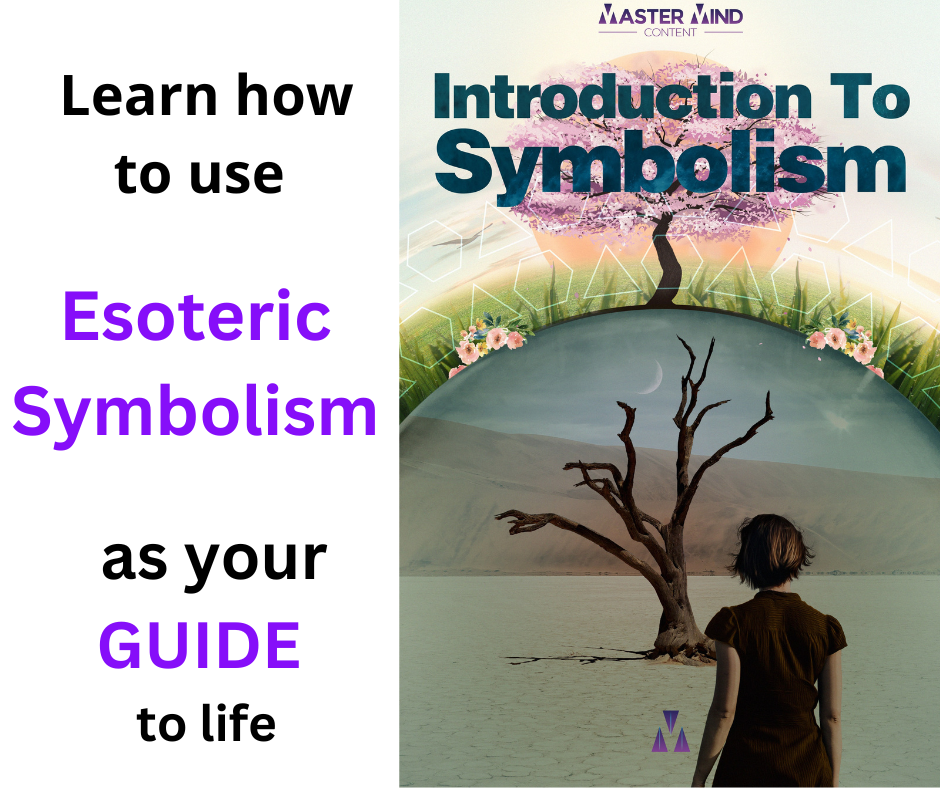
When I first began the research for my latest book, ‘The Search For Truth’ I stayed in a Buddhist temple in Bangkok and asked a monk there what elephants symbolised. He told me, “Thailand”.
Obviously, the monk was joking. But when I pressed him on it, he changed the subject. Perhaps the monk didn’t know, but I suspected he would have known something – even if it was only the superficial version offered to laypeople by Buddhist authorities: elephants are a symbol of good luck, strength, tenacity, intelligence, peace and composure they tell us.
Keeping the deeper meaning of symbols secret is how secret societies work. And don’t be fooled into thinking modern religions are not secret societies. Certain factions of organised religions harbour ancient wisdom that is concealed behind sacred symbolism and hidden from the knowledge of the masses they want to control.
The same exact symbols.
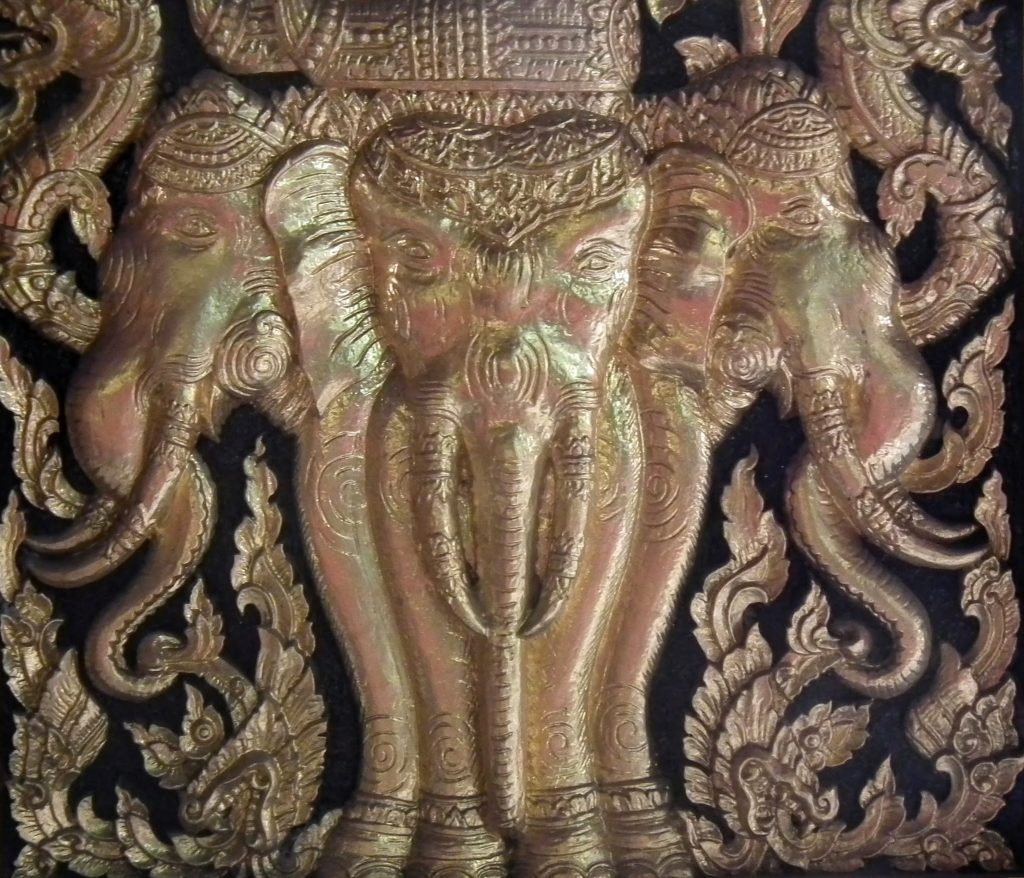
What’s more, organised religions conceal most of the ancient wisdom these symbols represent. All we are offered is a snippet of information which is nothing more than superficial advice, useless in and of itself.
When you have a deeper understanding of how the mind-body-energy system works with the natural laws of the Universe, you can apply the powerful teachings presented to us within religious texts in ways that are empowering, fulfilling and beneficial.
You have latent powers, they just need to be given a little nudge.
The ancient sages that developed esoteric symbolism used animals, plants and the elements of nature to explain the inherent qualities of man. The symbolic meaning of elephants reveals the strength and steadfast character of these impressive animals.
Whilst these qualities are the physical attributes of this powerful creature, the esoteric meaning relates to the human mind. Strength and steadfastness are merely qualities we need to cultivate in our thinking in order to transform kinetic energy (that has potential) into manifest energy (something we desire to create).
All energy has potential and all energy transforms. We manifest energy by how we think, feel and act.
Buddhist texts explain the way to reach Nirvana is to strengthen the mind and concentrate on one point of focus. We also have to show mental courage and patience to overcome adversity that life rolls into our path.
Strength of mind is the objective taught in many types of meditation practices.
The true symbolic meaning of elephants is somewhat misconstrued today. For example, in Asia, it is common for people to hang up works of art throughout their home, or stand ornate statues by the front door. They do this because they are superstitious and believe the elephant totem will bring them good fortune, and good health.
But it is not the picture or ornament of the elephant that brings fortune. It is applying the qualities of elephants that manifest energies into experiences we consider to be “good fortune.”
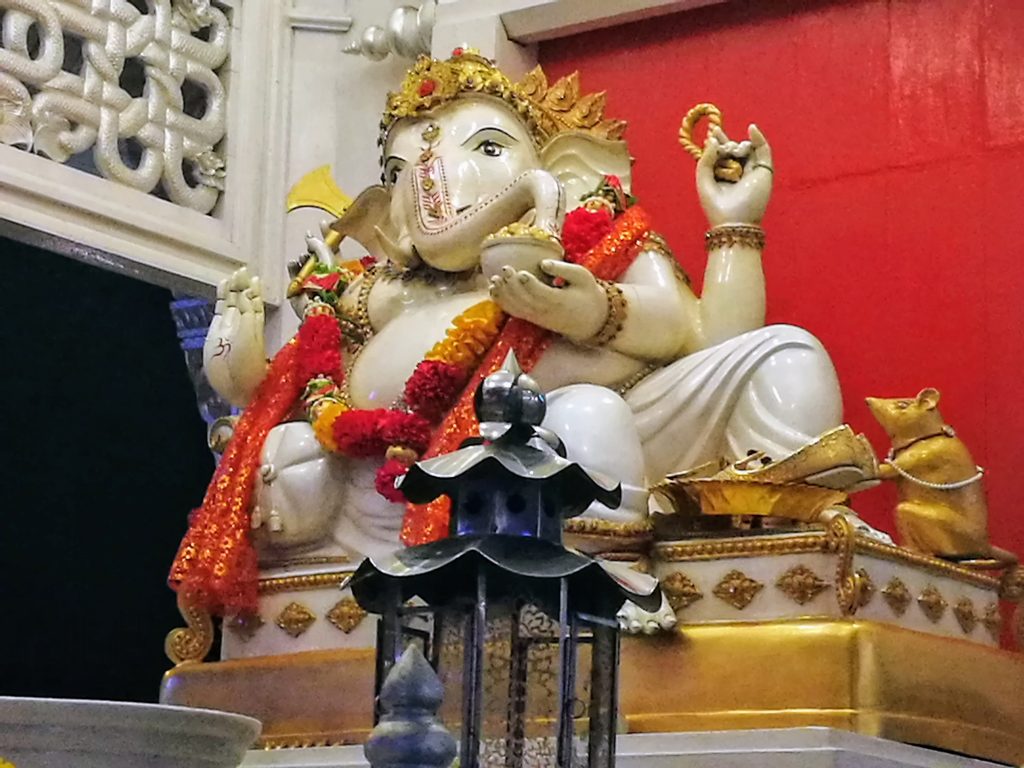
This is also how symbolism works. Read on, and I will explain.
On a fundamental level, we are told elephants are a symbol of strength and wisdom. On a deeper level, the symbolic meaning of elephants calls to us with a reminder to focus your powers on your inner strength; break bad energies – habits, attitudes and personality traits.
Once you do this you transform energy in a different way because you are thinking, feeling and doing things in a different way. As a result, you will have different experiences.
This mammoth of an animal is also a reminder for you to be responsible and accountable for your actions, to have the mental strength to stick to your goals and improve your ability to overcome emotions.
The pull of emotional strings is the hardest thing to overcome. This is the work of the dark aspects of the programmed subconscious; the little demon voice that leads you astray or tries to tempt you into self-gratification and indulgence.
Overcoming emotional weaknesses and being able to control urges is one of the hardest challenges you will face in life. These are the times when you are called upon most to summon the qualities of an elephant; strength, persistence and commitment.
In African folklore, elephants are honoured as former chiefs. They are venerated for their cooperation, endurance and devotion. The lesson for African tribes is to remain faithful to their leader.
The esoteric meaning of the “leader” to which you should remain obedient is your higher conscious mind, the Cosmic Intelligence that will give you everything you need. All you have to do is be silent and trust your intuition.
Just like elephants, the Super-Conscious mind is powerful and nurturing. But it is also destructive. This is the yin and yang that is inherent in nature. Energy also has opposite charges; positive pole and negative pole. Everything in nature needs to find equilibrium.
If you create energies with an uncontrolled mind, your conscious thoughts will stampede through life like a rampaging elephant. These traits are obviously the negative aspects of an elephant and something you never want to experience.
So why would you want to have this experience in your mind?
But an elephant is naturally calm and peaceful despite being a great hulk of a beast. This is how you want to train your brain to be.
So be still, listen to your intuition and have confidence in your higher Self. “Good luck” will come to you.
To trust the Universal Mind (God) to which you are intricately connected, you have to be able to listen. By ‘listen’ I mean, be still, silent, quieten the mind and become immune to all distractions. The ability to listen is represented by the huge ears of the elephant.
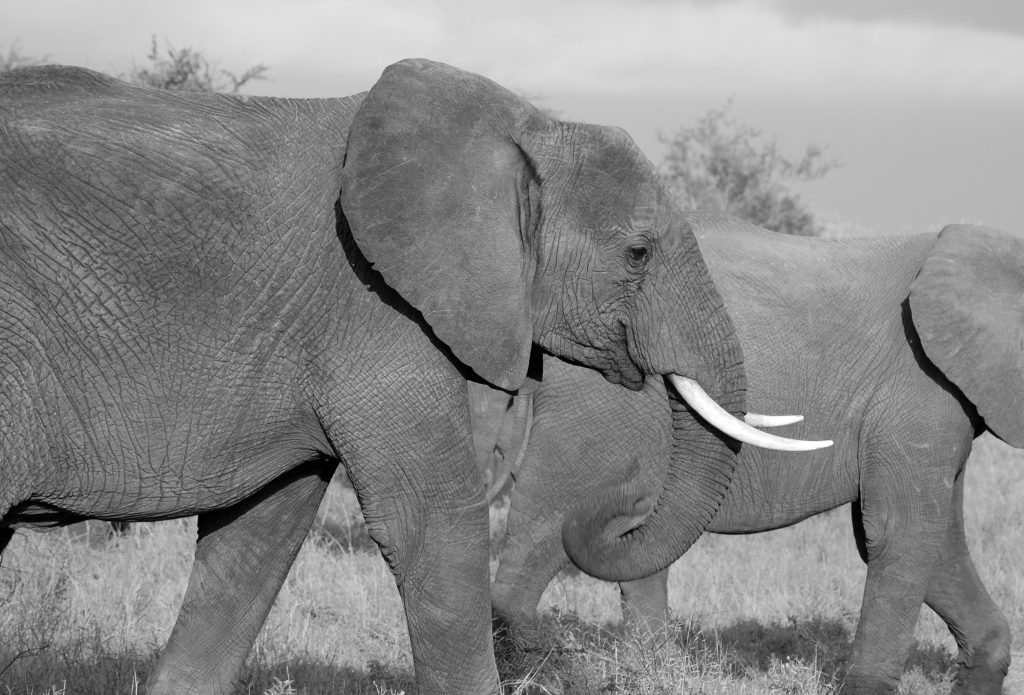
This is why it is important to train the brain to be still and concentrate on one single point of focus. If you are not silent, you are not listening. Thus you will not be guided by your Supreme Intelligence (Superconscious).
The elephant totem is also connected with the element of water thus reminds us to connect with our feminine principles; nurturing, compassion and caring. These are also qualities of the elephant that help teach us how to bring harmony into our lives.
When you have harmony in your life, arguments and disappointment cease. You feel content all the time and have control over your emotions – or to put it another way, you have control over the elements.
This is one of the meanings given to us in the Christian parable of Jesus calming the storm.
In Buddhist legend, the elephant is synonymous with the birth of Buddha; to be precise, a white elephant representing the purity of mind – the mind of a Bodhi.
It is said that on the night Queen Maya fell pregnant with Siddhartha (the future Buddha), a white elephant came to her in a dream, presented her with a white lotus and proceeded to circle around her three times before entering her womb on the right side of her body.
The white elephant is therefore connected to fertility, the ability to create. Again, we see here the elephant depicted as a symbol of mental strength – concentration – which is the principal aspect of how we manifest things we need in life.
The story of the historical Buddha’s inception promotes the idea of training your mind to be pure – empty and silent; and strong – fearless and determined.
Furthermore, it is said that when an elephant appears in a dream, it denotes overcoming an obstacle – a symbol associated with the elephant-headed god Ganesha. However, the Hindu god is also known to be the placer of obstacles, revealing that the mind can create a smooth passage or one fraught with difficulty.
This concept is also evident in Buddhist iconography. Grey elephants running wild or with demons on their backs denote a mind that is uncontrolled. Like an elephant fleeing in fear or rage, the uncontrolled mind is destructive.
Let’s look at another example, this time from Hindu myth.
The elephant-headed Ganesha is probably the most recognised god of the Hindu pantheon. In keeping with the wider symbolic meaning of the elephant, Lord Ganesha is considered to be the “Lord of Good Fortune who provides prosperity, fortune and success.”
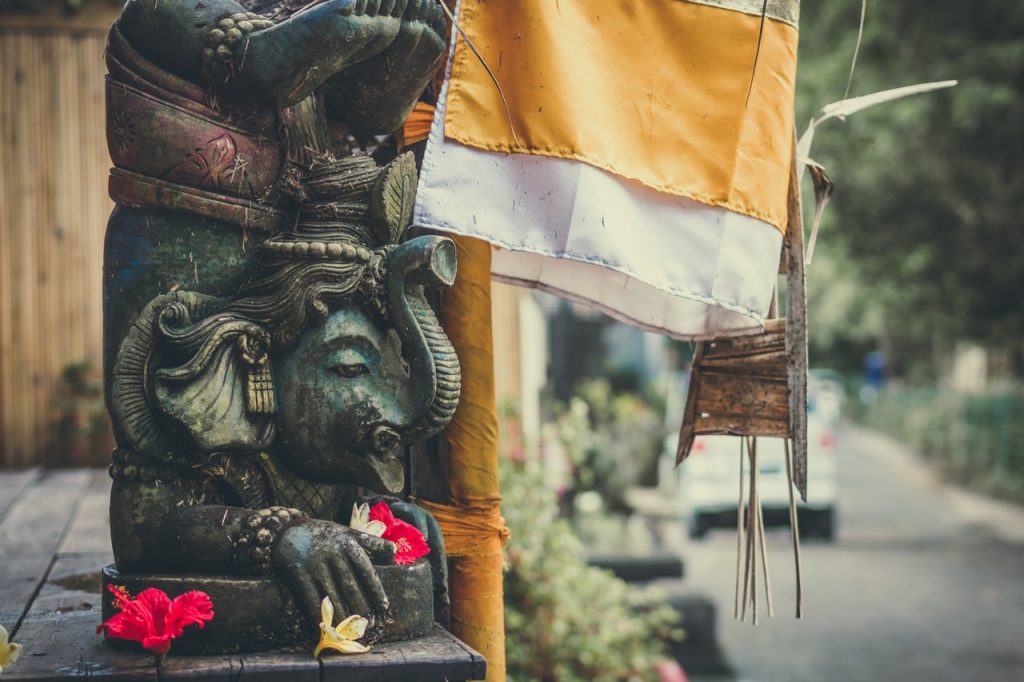
It’s important to note here the distinction between the meaning of the words prosperity, fortune and success. Ordinarily, they would be associated with money – thus in a physical or material aspect.
In a spiritual sense, prosperity relates to progression, fortune to good or bad luck and success to achievement. True wealth, richness, is overcoming material possessions and taking control of your emotions. When you can do this, you always feel content, satisfied, balanced and in harmony with your surroundings.
This is the state of Samadhi as the Hindus call it, or Nirvana as they say in Buddhism.
We need to look deeper.
Other attributes assigned to Ganesh are knowledge and wisdom. He is often pictured holding a book of scripture. It is quite obvious that we need knowledge. But it is by adopting the patience associated with elephants that we acquire wisdom.
Wisdom is achieved by acting upon the knowledge you have you gained.
Ganesha is also associated with beginnings and is the remover of obstacles. When his trunk is raised, it is symbolic of overcoming obstacles. This is true for any elephant you see in iconography.
A lesser-known attribute of the elephant-headed God is that He is also the placer of obstacles. His role here is to test initiates and determine whether you have learnt your lesson and worthy of good fortune etc.
This is important to remember because in life, and along the spiritual journey, we will encounter obstacles. But these challenges mean you are on the right path. However, you only know this is you are consciously aware of the path you should be on.
When you flow through life without any direction and are ignorant of the subconscious mind, you learn very little. This is because they do not realise you are being tested or what you are being tested on.
But the subconscious mind wants to evolve. We are energy and energy has to transform. We are consciousness and consciousness wants to survive and thrive.
Many of the elephant statues you will find in the Hindu and Buddhist temples of South-East Asia are the three-headed elephant Airavata, also known as Erawan in Thailand. In myth, Airavata is sometimes described as having 33 heads, signifying he is a master of the mind.
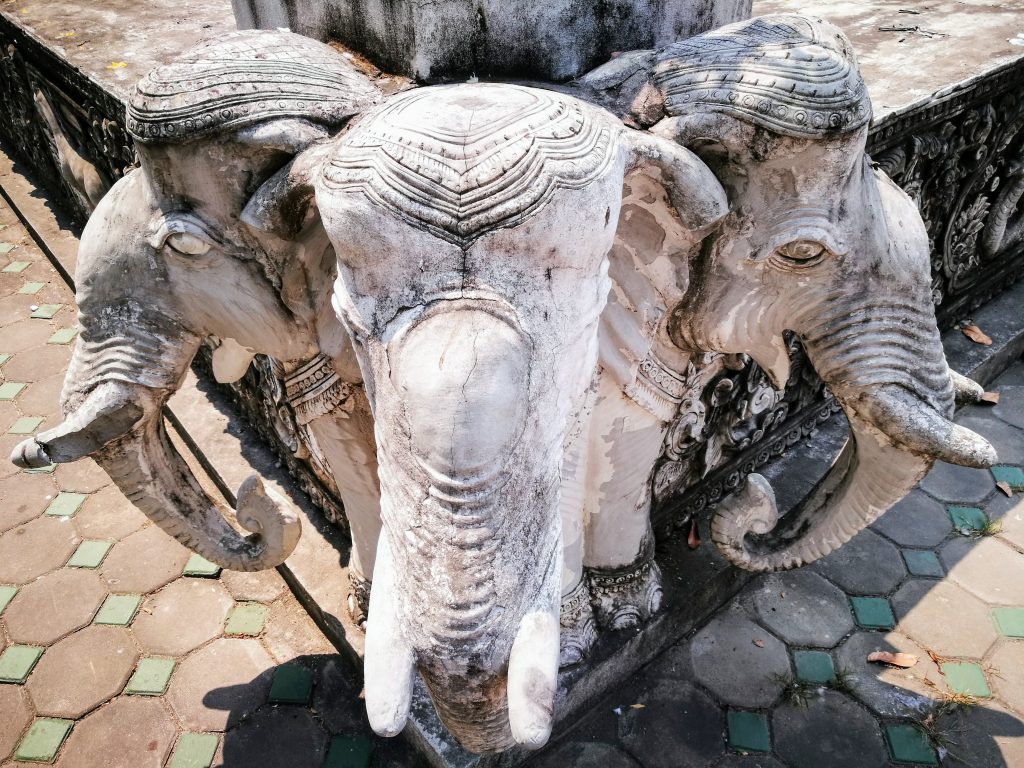
Airavata originally stems from Hindu mythology as the Vamana (vehicle) of Indra, king of the gods. In the Ramayana, Indra tells us that Airavata would not permit him to mislead people into thinking, or perhaps perceiving, something about him which was not true.
When the god was offered a garland of good fortune, Indra draped it on Airavata’s tusk in a gesture to say he had no ego. But Airavata knew better and cast the garland to the ground. Indra was grateful to Airavata for teaching him to be honest and without falsehood.
Here we see a reflection of the symbolic meaning given in Buddhism; the elephant remember is a symbol meaning ‘to be steadfast’ and unwavering for which you sometimes need the strength of mind to be patient.
Airavata could fly so is also known as the elephant of the clouds. Like Indra, the weather god, or thunder god, Airavata is associated with water and rain, indicating he resembles creative attributes.
Indra is the equivalent of the Zeus in Greek mythology and Thor in Norse mythology. All three carry a weapon that generates lightning bolts – a symbol that represents the connection between heaven and earth – the Super Conscious with the mortal conscious.
Airavata is an extension of this philosophical thought. In a battle against Indra and the dragon-demon Vritra, Airavata sucks up all the water from the Underworld and sprays it into the clouds.
This scene from Hindu myth reflects how a strong mind, when trained to be silent and concentrate, can cross the three realms; physical, ethereal and astral. Again, we see here why elephants are auspicious creates that represent power and peace.
With practice and patience, you learn to overcome obstacles. Mindfulness meditation helps you to cultivate your mind, emotions and actions. This is the process of transformation that will give you a better quality of life.
Just in case you’re wondering, the reason why I was seeing elephants is that I need to develop mental strength in my life again right now. On the one hand, I know I need to make a start on the writing of my book. On the other hand, I know I need a work-life balance to protect my health.
Subsequently, that means dropping some of my client work to free up time – at the expense of money. Writers don’t make a lot of money anyway so sacrificing a little more is not an easy decision to make. However, my subconscious has spoken. This week I started work on my book.
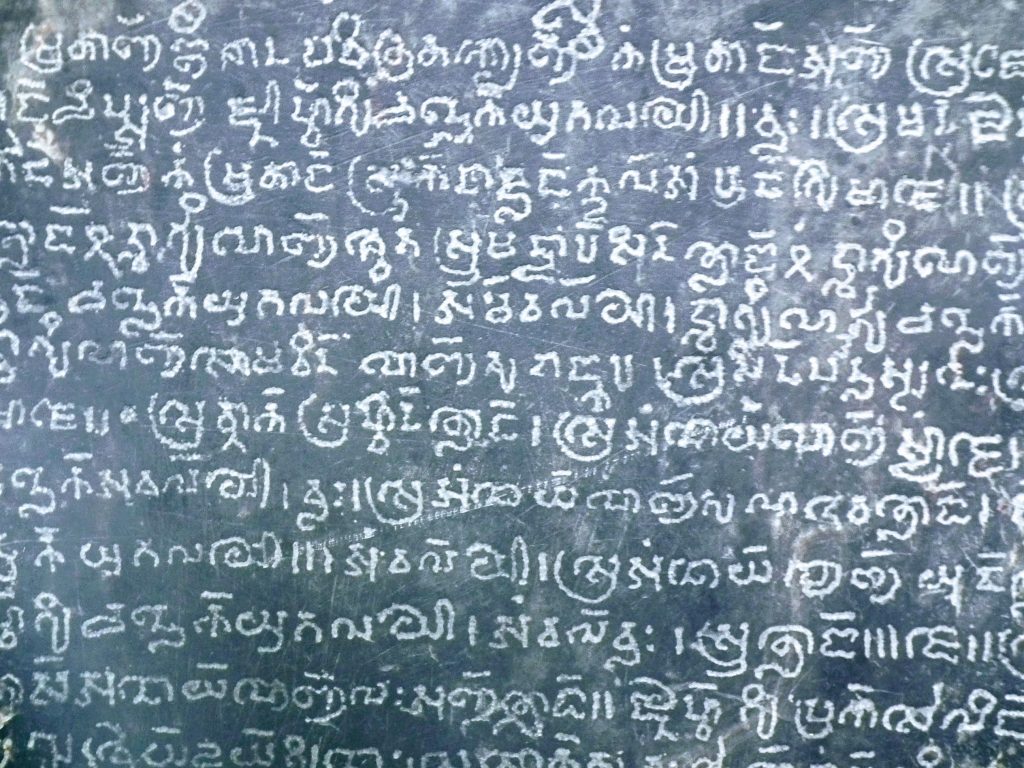
Vedanta forms the foundations of Hinduism but when approached from a philosophical viewpoint rather than religious dogma, the hidden meaning behind the pantheon of gods have an entirely different meaning.
The esoteric symbolism reveals the mind-body-energy connection. You can find plenty of content on this subject in the decoded symbolism throughout my website.
Perhaps one of the appealing things about Vedanta is that people don’t necessarily have to step away from their religious past if they still feel attached to it. However, Vedantists recommend it is best practice to forget a large portion of what you have previously been told.
The gods represent aspects of human nature. By praying to a god, you should only be looking to invoke the principle that is portrayed through that god. For example, Lord Shiva is known as the “destroyer”. Shiva, therefore, has a quality that is useful for when you want to change your habits, attitudes or personality traits that do not serve you.
Vedanta teaches initiates to focus on the ‘Self’. Observe how you feel, what you do and what has happened. When you analyse the experiences you have and question what you did to cause that experience, it leads you to self-discovery. This is the purpose of Vedanta.
Self-discovery is the most advanced knowledge of spirituality.
By all accounts, the most valuable lessons of Vedanta are found in the Upanishads, the Bhagavad Gita, and the Brahma Sutras. The Upanishads state the goal, the BG provides practical advice, and the Brahma Sutras explain the true nature of human existence.
When you understand alchemical symbolism, it becomes apparent that Vedic literature demonstrates the ancient scribes of these invaluable texts had a profound understanding of science and nature. Sadly, scholars overlook this because they have been ingrained to think our ancient ancestors were primitive and could not possibly have the knowledge we have today.
Academia is ignorant and arrogant in my view.
Vedic literature explains that all creation comes from primal matter. They called this matter, Akasha. Modern science also explains universal forces have one root that begins motionless and unmanifested, before combining attraction and repulsion to create gross forms.
The modern English word for matter comes from the Egyptian Goddess Ma’at, the mother goddess. This became mater in Latin, mutter in German, and finally, matter in English. So matter comes from the root word, mother. When women give birth to children, they create.
In ancient symbolism, a mother giving birth to a child is analogous of the dynamic forces of matter creating everything we see around us.
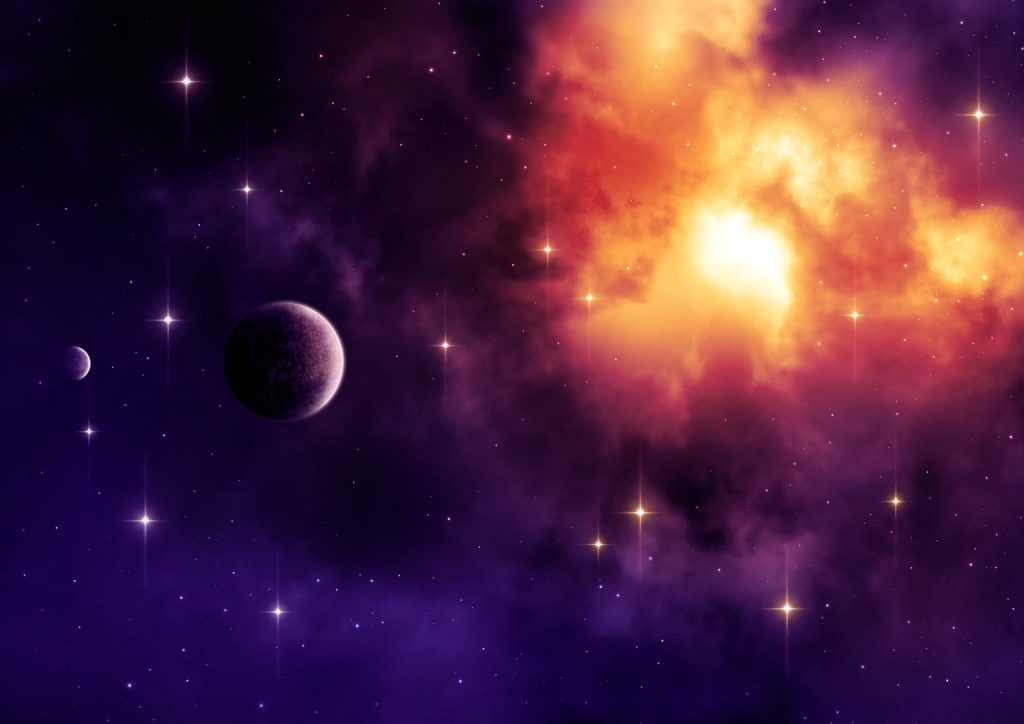
Beyond explaining how the Universe was created, ancient texts that form the philosophies of Vedanta describe the true nature of man. We know today that man is composed of the same elements we find in the Universe. Carl Sagan once famously said: “We are made of star-stuff.”
“The nitrogen in our DNA, the calcium in our teeth, the iron in our blood, the carbon in our apple pies were made in the interiors of collapsing stars. We are made of star-stuff”. ~Carl Sagan
Vedanta is the oldest philosophy to claim we are all one. At least that’s what we are told. What is actually means is we are all energy, and thus connected to the same energy source; the all-presiding presence of the electromagnetic field.
Furthermore, energy never ceases to exist. The laws of thermodynamics say that the entropy of energy never gains or loses energy. It only transforms.
Consciousness is also energy, and I suspect you know from experience that you have the ability to expand your conscious awareness – if you choose to.
Therefore it is possible to transform our consciousness – our understanding – of the world around us. I suspect you know this also.
But the problem is, a lot of the information we record in our subconscious does not liberate the conscious mind from the illusion of the material world. Because we don’t know anything different.
Vedanta explains that we can transform energy by acquiring knowledge and acting upon it. This is how we develop wisdom. With the benefit of wisdom, we can create better experiences for ourselves. How we experience that the world is determined by how we perceive the world. And our perceptions are formulated by past experiences.
Our attitudes, beliefs, personalities and perceptions are products of our past. What we experience ultimately gives us a sense of Self. But this sense of Self comes from our interaction with the material world. The world of illusions. It is not necessarily a true understanding of who you are. It rarely is.
The deluded self is termed “ego,” but even this term is misunderstood.
If we use Sigmund Freud’s description of the ego, we can say it is the conscious mind that does the decision making. But ego is fed thoughts and ideas from the unconscious mind which Freud tells us is divided into two further parts which he called the id and the super-ego.
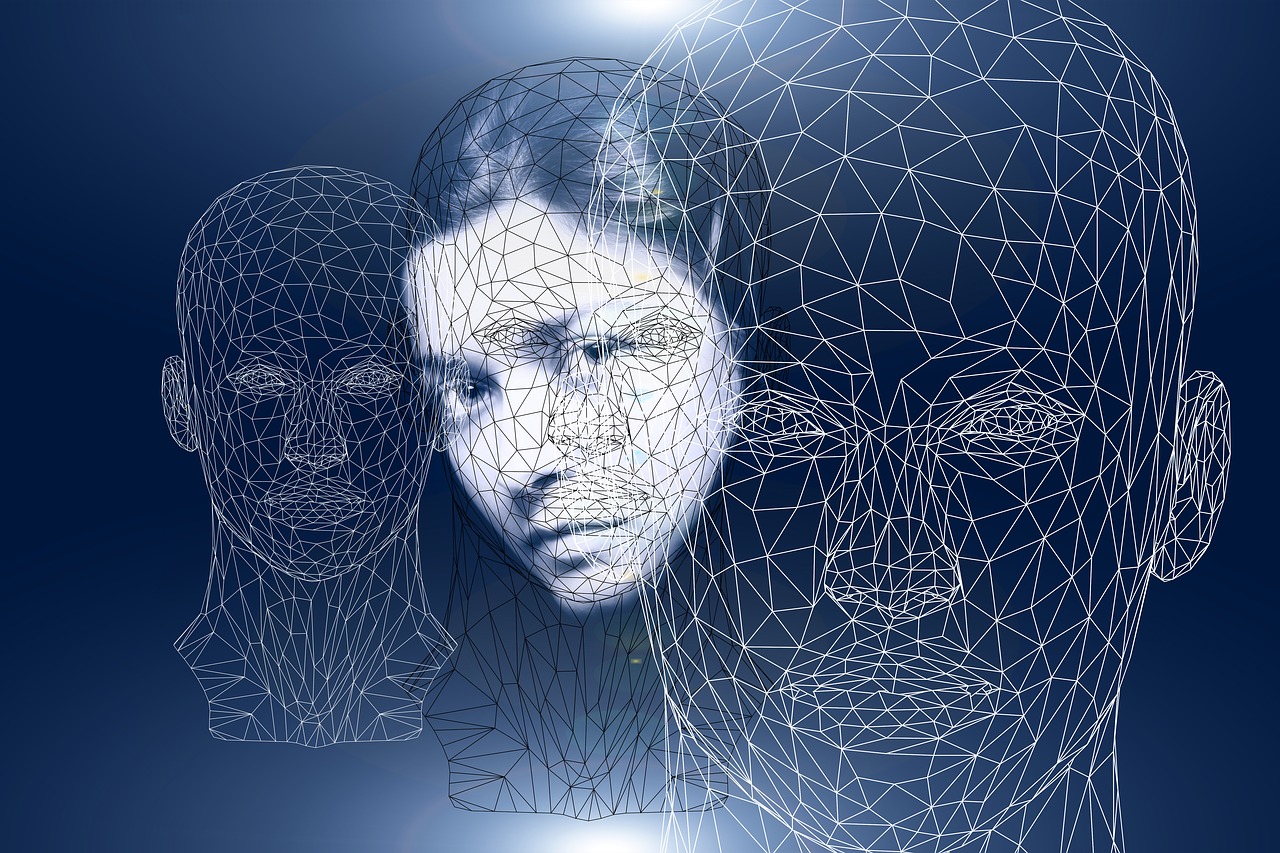
To explain this in another way, you could say that the id is your lower conscious nature. In ancient myth, the lower conscious mind is symbolised by demons and animals. The super-ego is your higher conscious nature, symbolised by the pantheon of gods in Hindu mythology.
This is why it is important to observe your inner-world. And you can do this to great effect by observing what happens to you in the outside world on a daily basis.
Thoughts that enter your head is the result of all the information you have stored in your subconscious. Regardless of whether the information is true or false, the decision you make is influenced by your subconscious. The only way to determine the “Truth” is to observe how you feel.
When you are in control of your emotions, you can take control of your mind.
Vedantists affirm that anybody can purify the mind and become aware of their true nature. When you reach this stage, you do not feel compelled to do anything. You can just allow things to happen and whatever you need will manifest as reality.
When you are in-tune with your true nature, you do not have to think about what to do, you instinctively know. When you move away from ego and into the mind of Brahman, you have a complete understanding of the true Self. Then you can enjoy life.
The story is a charming analogy of how the mind works; the Buddha is the enlightened mind; the elephant represents qualities of mind we need to develop, and the monkey represents the mind of the average person that is easily distracted.
The Buddhist legend of the Buddha, the elephant and the monkey should not be confused with a piece of Buddhist artwork that also involves an elephant and a monkey. Albeit, the two portrayals do allude to the same meaning.
In the artwork, a Buddha is seen chasing a black elephant that is being terrorised by a monkey. The scene at the bottom of the hill represents the distracted mind. When the Buddha catches up with the elephant and takes control, the elephant transforms into a beautiful white creature and the monkey gives up the chase. The elephant and the Buddha continue to the top of the hill undisturbed.
This iconography is one way of using animals to describe the nature of the human mind. But both the elephant and the monkey have other qualities that are also used to teach initiates how to develop attributes that improve your quality of life.
Do you know the Buddhist myth of the elephant and the monkey serving the Buddha in Rakkhitawan forest? If not, you will like this story and can probably associate with it on several levels:
During his ninth year of ministry, Buddha Gautama resided at a temple in Kosambi. The temple was the home of Buddhist monks that supported two schools of thought on Buddhism. Subsequently, they were always arguing about which philosophy was right. Siddhartha attempted to settle the quarrels, but the stubborn monks continued to argue amongst themselves.
Tired off their bickering, the Buddha decided to retreat from the temple and set up camp in the nearby hills of Rakkhitawan Forest. (Rakkhitawan Forest is specifically related to the Thai version. In other versions, the Buddha retreats to Parileyyaka Forest). When news of his arrival spreads amongst the animals, an obedient elephant comes to serve him.
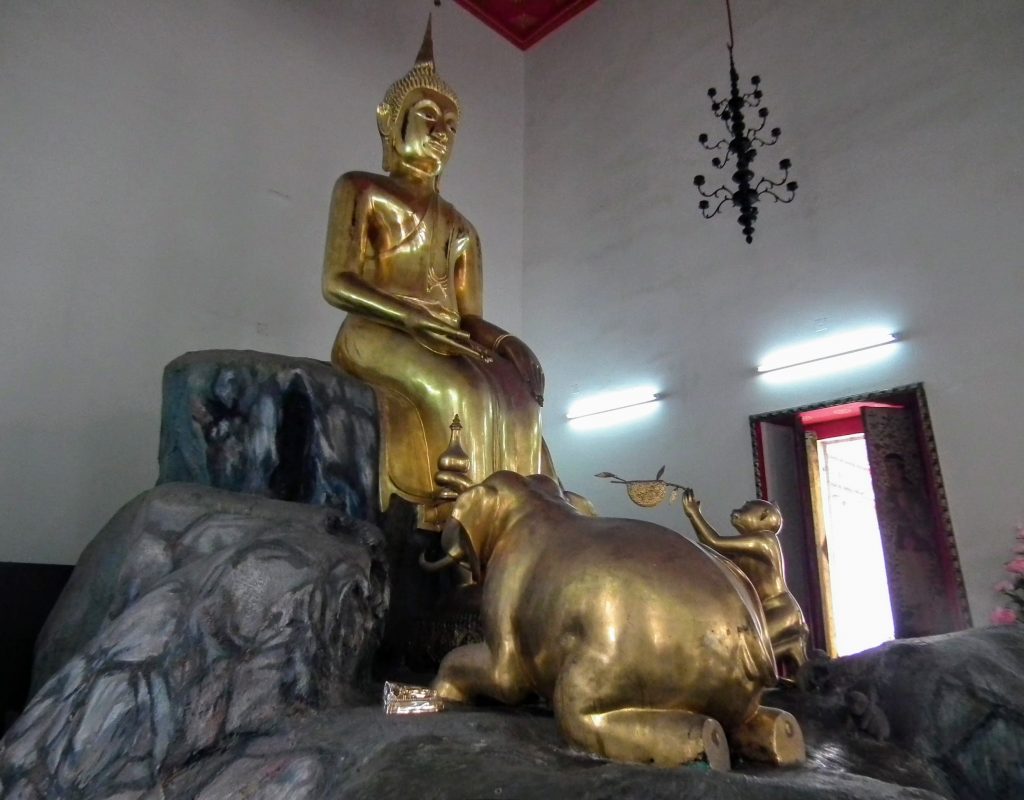
Each day the elephant would bring the Buddha fruits and perform tasks for him to make his stay more comfortable. Lord Buddha was very grateful for the elephant’s attentiveness and dedication.
The Buddha accepted the gift graciously and laid it to one side. Later, noticing the honeycomb had gone untouched, the monkey examined the gift to determine why the Buddha had not indulged in the nectar. Upon examination, the monkey noticed some unhatched eggs and immediately understood why the Buddha had not touched the honeycomb.
To rectify the matter, the monkey removed the eggs and returned them to the hive. Siddhartha, in acknowledgement of the monkey’s good deed, ate the nectar. The monkey was so overjoyed the revered Buddha had accepted his gift that he began leaping from tree to tree and swinging from the branches.
However, in his excitement, the monkey became complacent and lost his grip. He fell and impaled himself on a spike protruding from the ground. The monkey died. But because his good deeds were recognised by Lord Buddha, he was reincarnated in the World of the Thirty-Three Gods.
The story of the Buddha being served by the monkey in Rakkhitawan Forest/Parileyyaka Forest reflects the state of mind and the qualities you have to develop to improve your quality of thought and action.

In Buddhist symbolism, the elephant represents inner strength and patience, attributes you need to develop in order to achieve purity of mind. The elephant brought fruits to Lord Buddha in recognition that he had already achieved mastery over his mind.
However, even Buddhas sometimes need to be reminded of the greatness. The only reason the Buddha was in the forest in the first place was because he had grown annoyed with the bickering of the monks.
Buddhas should not allow trivial behaviours to disturb them. In such a situation the philosophy of non-action should be applied; the ability to overcome any situation by being immune to outside influences.
In part, this concept is symbolised by the monkey; renowned for being mischievous, unsettled and easily distracted. These attributes are also associated with a mind that is undisciplined, easily distracted and craves attention.
These are qualities of people that have no control of their mind or emotions. Buddhists call this the “monkey mind.” The monkey appears in many forms; sounds, thoughts, cravings, restlessness, fear etc.
Monkeys are also social animals. The appearance of the monkey in the forest is also to reinforce the idea that Siddhartha should not seek solitude to escape other people. His actions showed a lack of intolerance which goes against his own teachings of what it means to attain Buddhahood. Even the greatest minds can lapse.
Most people in the modern world do not have the opportunity to luxury or the opportunity to escape the mindlessness of others on a daily basis. So we have to create a forest in which the elephant brings us the fruits of a heightened state of consciousness.
Buddhas have the ability to develop a neutral association with the world around them and accept that others want to be recognised and accepted. This is why people have opinions and need others to agree with them in order to feel appreciated. But these feelings are the needs of deluded people.
The death of the monkey reflects the Buddhist thinking of reincarnation, death and rebirth. What this actually relates to is the transformation of energy. Death in myth represents new beginnings which manifest when old attitudes, beliefs and behaviours change.
Note also how the monkey is permitted to reincarnate in the World of the Thirty-Three Gods symbolising mastery of mind and emotions. The overarching message of this story is that when you show intelligence, understanding and compassion, and put the care of others before yourself, this is the purity of mind and heart. Remember, this is also what Buddha Gautama had to be reminded of in this story.
This article explains the esoteric meaning of the hexagon. It’s quite in-depth. If you’re short of time, or can’t be bothered to read right now, check out the truncated version: the symbolic meaning of hexagons.
Of all the geometric shapes in sacred geometry, the hexagon is arguably the most powerful. And fascinating. The six-sided geometric shape is found in many spiritual symbols such as the Star of David, The Tree of Life in the Kabbalah and the Hagal Rune composed by ancient tribes of northern Europe.
The Star of David, also known as the Seal of Solomon, is believed to be one of the oldest symbols ever used. Although its origin is unknown, it probably existed long before it was incorporated into the philosophies of Judaism.
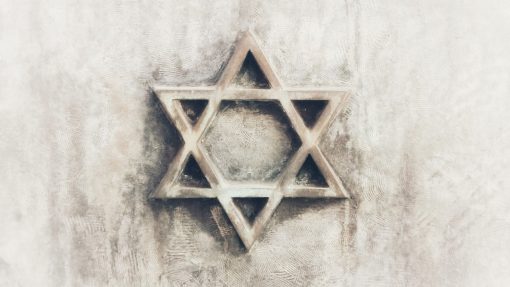
You find the hexagon in the centre of the Star of David. It is the sacred geometry formed by the interlocking of two triangles – the upward-pointing triangle representing positive/male energy, and the downward-facing triangle representing negative/female energy.
That is not to say that men are positive and women are negative. It is merely the expression of energetic charges; the positive and negative charges in electromagnetic energy and atoms; protons and electrons.
For instance, the atom is made from positive particles known as protons (male energy) and negative particles known as electrons (female energy). Atoms have an equal number of electrons as there are protons in order to find stability and balance.
Electrons also ‘mate’ with protons. In alchemy, this process is sometimes referred to as the ‘chemical union.’
Well, that’s the scientific meaning of balance represented by the hexagon, but it’s not really that useful. The honey of the hexagon is revealed when you explore the esoteric meaning of the hexagon from the perspective of psychology.
This is when you can use symbols as a tool to guide you through life.
When you balance emotional intelligence with reason, you evoke the forces governed by the universal laws of nature. Channel your energies and you become the creator of the reality you imagine yourself to be.
“The more concentrated it is, the more power is brought to bear on one point, and that is the secret.” ~ Swami Vivekananda
In the Kabbalah, you find a complex system that uses sacred geometry to explain the meaning of life. In its most basic form, this system of mathematics and geometric shapes is known as the Sephirot – or more commonly the tree of life.
However, the end product that sprouts from the Tree of Life is the Flower of Life. Hidden in the patterned network of circles is the fruit of life which is said to open the gateway to higher consciousness.
The Fruit of Life is composed of 13 circles within the pattern of the flower of life. It is the same pattern as the Hagel Rune from Nordic traditions.
The number 13 is also synonymous with unity and the transition between the physical realm and the spiritual realm.
This is why we often find the number 13 expressed throughout many ancient cultures as 12 around the one:
Furthermore, the 12 Gods in Greek, Roman and Zoroastrian myths represent the 12 personality archetypes of an individual. The reference to 13 augurs a man that has integrated the 12 archetypes and discovered his True Nature.
We see this more clearly in the theory of psycho-analyst, Carl G. Jung, in the 20th Century. Jung outlined 12 archetypes which he believed to be the key attributes to adopt to become complete. Jung was heavily influenced by ancient teachings.
When you draw straight lines through the centre of each of the 13 circles, it forms a six-pointed star – the basis of a hexagon when you join all the edges together.
The crudest and most beautiful depiction of a hexagon is the six-pointed star. In its most striking form is the crystallisation of water which is demonstrated in an experiment conducted by Dr. Masaru Emoto.
In its most crude form is the Hagal Rune devised by the ancient shamans of the Nordic tribes. This ancient symbol bears a striking resemblance to the image of the water crystals. It should come as no surprise the ancients got the idea for the Rune from nature.

The Hagal Rune also appears like a conceptual star. The scientific community believe many of the elements found on Earth were originally formed in stars and released as the stars burnt out and died.
We find the same pattern used by the Nordic tribes of northern Europe buried in the flower of life. In the Kabbalah, it is called the ‘fruit of life.’
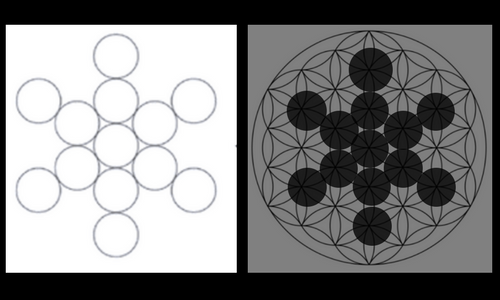
The fruit of life is referred to as the ‘fruit of spirit’ in Christianity. The fruit of spirit relates to the nine virtues of man according to the Apostle Paul in his letter to Galatians; love, joy, peace, patience, kindness, goodness, faithfulness, gentleness and self-control.
The verse in Galatians 5:23 goes on to state: ‘against such things there is no law.’
In other words, the nine attributes are what comprise man’s True Nature. When you master your emotions you become complete, and the mirror-image of the hexagon becomes one. The True Self returns to the “source”.
We hear the word “source” a lot in new-age spirituality. But what is the source?
When hexagons reveal themselves to you, it’s a sign to take notice of unconscious content awakening in your conscious mind.
This wisdom is revealed in the triangles that come together to create the Star of David. We are told that the two connecting triangles are the union of male (upward-facing triangle) and female (the downward-facing triangle).
The esoteric meaning lying veiled beneath this explanation relates to the wisdom of the unconscious penetrating the conscious mind; the emergence of waking consciousness you were previously unaware of.
“The number 6 is most skilled in begetting, for it is even and uneven, partaking both of the active nature on account of the uneven, and of the hylical nature on account of the even, for which reason the ancients also named it marriage imd harmony … And they say also that it is both male and female … And another says that the number six is soul-producing because it multiplies itself into the world-sphere, and because in it the opposites are mingled.” ~ Carl Jung, The Practice of Psychology, CW 16. par 451
The “Alchemical Marriage” symbolically describes how thoughts program your subconscious. It’s common knowledge today that the subconscious responds to the power of your thoughts.
In mythology, fatherly, male characters symbolically represent the mind. Mothers and other female characters or symbols relate to the unconscious.
From an esoteric viewpoint, the upward-facing triangle is the active power or seed of man; logical thinking, analytical thought, reasoning courage and willpower. It is your thoughts – the seeds – that “impregnate” your subconscious mind; the feminine.
You may have read that the downward-facing triangle is “passive energy,” “the receptive element”, or “womb of the feminine”. Now you know the down-facing triangle represents the subconscious, you can see what the esoteric meaning of the hexagon is. It makes much more sense than the misleading fragments offered by other sources doesn’t it?
The number six is commonly known as a number of the weak-willed. The infamous 666 is assigned as the ‘number of the beast’ to represent individuals that are controlled by their animal nature in body, mind and spirit (conscious mind, personal unconscious and superconscious).
A weakness of man is the inability to overcome temptations. Cravings are the basic instincts of your lower-conscious nature. When the mind is unable to overcome urges that rush up from the subconscious, you are bound to the material world.
In the tarot, the Devil card of the Rider-Waite deck depicts the Beast holding a man and woman captive. Around their neck is a shackle and chain. But the shackle is loose enough for them to take off – if they were aware of the possibility and had the will to do so.
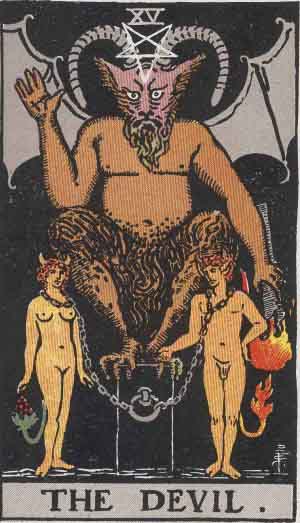
The hexagon, and the six, is an opportunity for you to identify your weaknesses (or sins) and upgrade your personal programs with good qualities.
You can identify your strengths and weaknesses in the archetypal energies reflected in world mythologies. The pantheon of 12 gods represents human nature and shows us which aspects of consciousness we have mastered, which we need to develop and which need to be deflated and brought into balance. The gods can be helpful, magical and brave, but also jealous, spiteful and vicious.
Negative traits that express the six are disconnection, being hypocritical, weak-minded, shallow, submissive, restless, selfish and easily stressed.
On the flip side, the number six is connected to healing. One form of healing is through self-realisation, recognising unconscious content and integrating it into the conscious mind.
These character traits are present in the archetype of the Sage which I associate with the Greek God Apollo. Apollo was born on the sixth day of March. His son, Asclepius is the god of healing.
Zeus, Poseidon, Hera, Athena and Hermes are also associated with the number six, all of whom share a connection with knowledge, wisdom or healing.
Can you see how exoteric symbolism pieces together to reveal esoteric secrets?
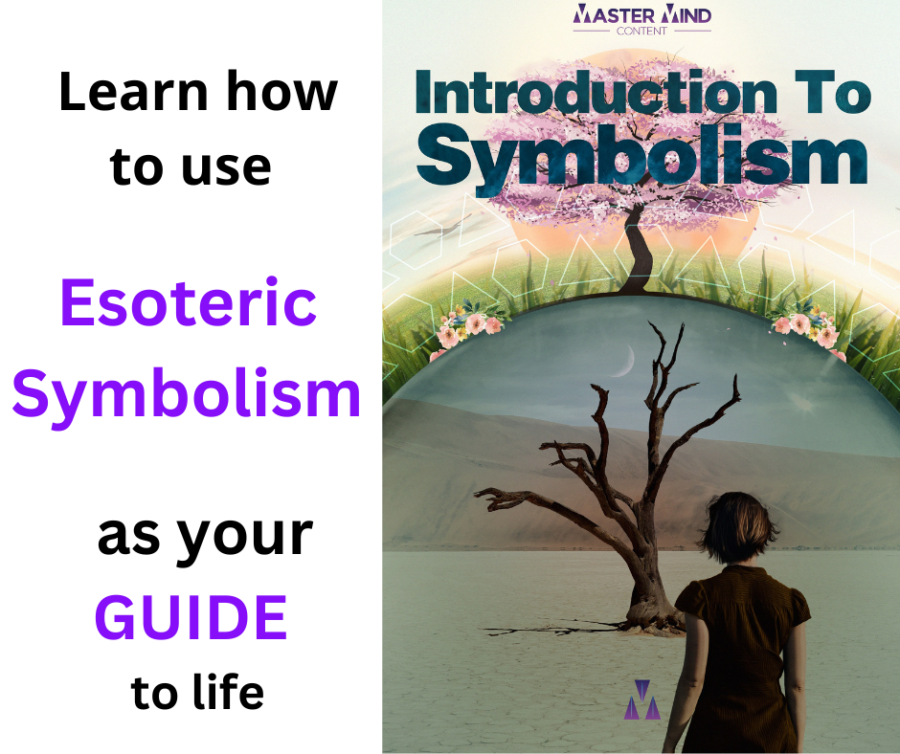
One last thing. Men have to nurture the passive feminine principle of feelings (Jung’s anima), and women have to integrate the active masculine principle of the creative mind (Jung’s animus). This is how you cultivate balance and healing.
Because the personal unconscious is often programmed with poor information the ego responds to, developing self-awareness is a challenge many people fail to overcome.
Whilst wisdom can be reached through self-analysis, reason and logic, you will come to a point of self-realisation much easier and quicker if you are guided by esoteric symbolism.
In this article, I will breakdown the esoteric meaning of the 14 Lokas in Hindu mythology and discuss the mental states of each one individually.
Vedic cosmology is fundamentally based on sacred sciences. So are other religions for that matter. Once you understand the true meanings of esoteric symbols, it becomes apparent that ancient civilisations had a profound understanding of the human psyche, biology, physiology and, arguably, quantum physics.
The 14 Lokas in Hindu mythology, for example, explain states of mind. The seven upper worlds describe states of mind when you are balanced, happy and in perfect harmony – or near-perfect harmony – with your environment.
In contrast, the seven lower worlds describe states of disharmony. The Lokas are essentially the yin-yang of your chakras – the duality of positive (good) and negative (bad) energies.
When your energy centres are open and in balance, you feel much better about yourself, emotionally mentally and physically. The reverse is true when your chakras are out of sync.
How many times have do you feel glum, melancholic or fatigued and don’t know why?
It is because your energies are unbalanced.
Well, now you know why. Or partly. Understanding the 14 Lokas will give you more indication of why you might be feeling low or experiencing bad luck (unbalanced negative energy). And once you identify the issue, you can work on the solution.
Some commentators think the Lokas are actually planets somewhere in the solar system. And they may well be, but there is no way of ever proving that in this lifetime. So there is really no point discussing it. But hey-ho!
In my opinion, the Lokas reveal the states of mind. Is it not true that you fluctuate in and out of consciousness on a daily basis? Your thoughts are constantly changing, and so are your emotions. Thoughts and emotions come from the subconscious mind.
You will know from experience that your moods change without any real explanation. How can you go to bed one-night feeling content, then wake up the next morning feeling restless?
The seven upper worlds of the Lokas, or vyahrtis, represent your higher states of conscious awareness. When you expand your conscious awareness, the components of your body vibrate at a higher level of frequency and you feel better about yourself.
You also see through the veil of illusion and recognise the Truth of the real world more often. Subsequently, your experience of life is more profound and satisfying.
The seven upper worlds range from being fully awake to your Buddha nature, down to above average state of consciousness whereby an individual is grounded and confident. In between are the various levels you pass through on the path to Nirvana.
It’s worth noting that you do not have to be spiritual or follow any religious practices to expand conscious awareness. All you have to do is observe your subconscious mind, know yourself and make small changes to your daily practices to transform bad energy.
Hindu myths explain the Lokas in the upper worlds are where the gods reside, and the lower realms are where the demons reside. Don’t take this literally. Gods are symbolic of higher states of conscious awareness (good energy) and demons are lower states of consciousness (bad energy); ignorance, anger, hate, weakness etc.
Said to be located on Mount Meru, Satya-Loka is the home of the Hindu Trimurti; Vishnu, Shiva and Brahma. It is described as “the highest of the joyful worlds” and, according to Buddhism, is impermanent.
Satya-Loka in Hindu mythology is the state of mind you reach when you experience Samadhi or Nirvana. It is the moment of Absolute Truth which the Hindus associate with Brahman – the all-seeing, all-knowing master of the Universe.
To put Satya-Loka into perspective, have you ever experienced an a-ha moment when you felt elated and knew – you just KNEW – it was right?
That’s Satya-Loka.
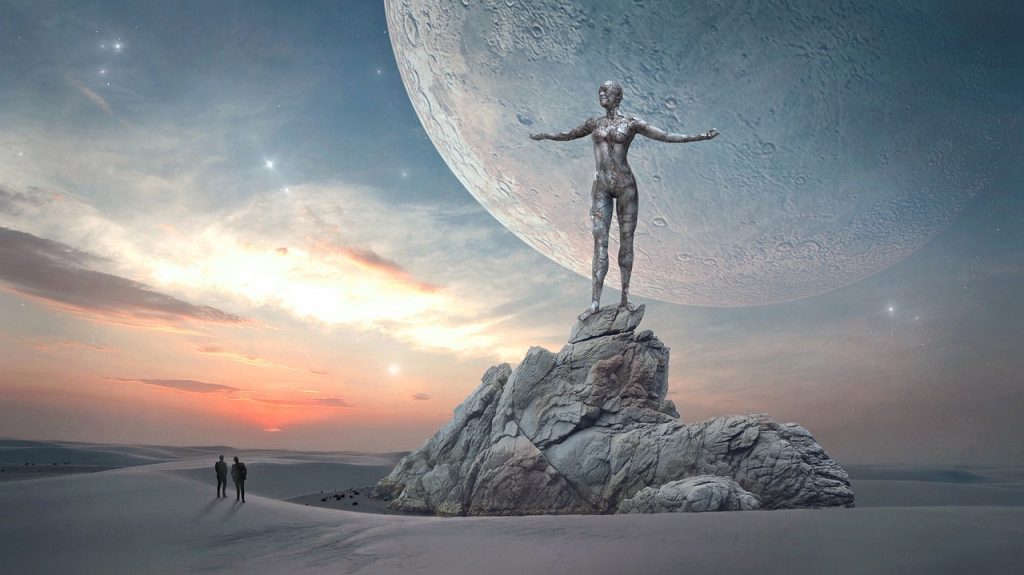
Most people will only get brief glimpses of Satya-Loka unless you strive to attain full enlightenment. But even then, as Buddhism explains, you can’t stay in that sense of heightened bliss permanently otherwise you would be in a constant state of rapture. You will literally be out-of-this world.
However, once you attain enlightenment, you do retain the benefits and powers of Satya-Loka, but live in a state of mind that enables you to operate in the real world on a daily basis.
Whereas Satya-Loka is impermanent, Tapa-Loka is the state of consciousness buddhas retain after they reach enlightenment. It is a state of eternal bliss. When you reach this state of mind, you are capable of creating anything you need in life because you are guided by divine consciousness – the highest faculties of mind.
The inhabitants of Tapa-Loka are the four Kumaras – the enlightened sons of Lord Brahma. Given Brahma represents Mind, the four kumaras represent the four faculties, or powers of the mind; intellect, imagination, inspiration and intuition.
The four Kumaras are pure and have no desire other than to teach. In the Mahabharata, they are described as Nirvitti, – inward contemplation. When you are capable of deep introspection, you can achieve everything you’re supposed to.
Jana-Loka is said to be the abode of the great saints and sages. This is the realm of the Akashic Library which you want to be accessing. You will not achieve anything in life without first attaining knowledge – and the highest forms of knowledge have come from wise men of the ages.
The Vedas position Jana-Loka 80,000,000 yojanas below Tapa-Loka, thus the realm is associated with the number eight. In turn, the number eight is associated with “God-Consciousness” – the state of mind awakened mystics, yogis, philosophers and other spiritual teachers should attain in order to teach others.
It is said that the Rishis living on Mahar-Loka have a life span of 4,300,000,000 solar years – this is associated with the number seven (4+3), a symbolic mathematical principle you calculate using gematria. In ancient mythology, seven is associated with the Mother Goddess, who in turn is associated with emotions.
The state of mind represented by Mahar-Loka, therefore, is tied to emotional understanding; the power of patience and the ability to care and nurture.
As you move into the lower sections of the seven upper Lokas, you will start to recognise everyday traits you are probably more familiar with. Svar-Loka, for example, is said to be the realm which is inhabited by the 33 Vedic gods, the head of whom is Indra.
Indra is regarded as the King of the Gods and recognised as a war god or storm god, and we often find him fighting the asuras (demons, which represent bad habits, or bad energies) with his vajra – a weapon that fires a lightning bolt.

In essence, Indra is the aspect of your nature in circumstances when you are called upon to summon courage and confidence to overcome challenges. This is how you expand conscious awareness and cultivate more quality in your life.
Indra also has destructive qualities which represent our dual nature. Sometimes you succeed, sometimes you fail. When Indra takes Soma – a hallucinogenic plant – he loses control of the world – the body and mind – and has to battle with demons to restore order.
As a unit, the 33 Gods represent the highest state of conscious awareness. For example, in Freemasonry, the Grandmaster is a 33rd-degree mason which reflects he has the power to overcome his thoughts and emotions.
Jesus also reflects man in a heightened state of conscious awareness. Jesus dies at the age of 33, and in the story of the Passion, he “sacrifices” himself and is seen forgiving the Roman soldiers that torture him.
Making sacrifices means giving up bad habits or changing attitudes, belief systems and actions that do not serve you well. Sometimes these changes are difficult – which is why you have to summons the courage and weaponry (powers of mental faculties) of Indra to overcome your weaknesses.
In the Vedas, Bhuvar-Loka is described as a realm with Earth-like qualities but is inhabited by semi-divine beings. These semi-divine beings are essentially humans that have found inner-peace and live a happy and fulfilling life.
In this state of mind, you vibrate at a high frequency that, I would say, is above-average. As a consequence, you feel confident and content with your life most of the time. You do not pine for anything and on most occasions have command over your emotions and actions.
When you live in this state of mind, most things you do, or try, results in success. You are happy with yourself, have strong relationships, and a content work-life. Sure, you are still prone to the odd error, but this is also human nature. Bhuvar-Loka is a state of mind that everyone should strive towards – at the very least!
Bhur-Loka in Hindu mythology is the realm that reflects planet Earth. The people that inhabit this lower realm of the higher Lokas are people that are awake but do not assert much effort into self-development and try to reach the higher realms.
In this state of mind, you are typically neutral. For example, you could be aware of the corruption and injustices of the world, but do not let that concern you too much. You won’t stand up and fight for your rights, but you won’t moan and complain about it either.
People in this realm are not overly concerned by material possessions or overcome by desires either. You may have ambitions, but you are even-keeled, grounded and go about your business at your own pace.
Now you have a feel for how the Lokas represent states of minds and the types of attitudes associated with the various mindsets, let’s take a closer look at the lower worlds of Hindu mythology.
No offence, but you may well find states of consciousness you can associate within this section.
The lower realms are described in the Puranas as dark planets thus represent lesser states of consciousness. In terms of character traits, the inhabitants represent opulence, materialism, and desire.
The lower seven realms go down into the pits of Hell. And we’ve probably all felt like we’ve been that low before. However, I imagine most people reading this blog will put themselves in the upper-lower worlds. The good news is, you won’t have that much work to do to restore equilibrium.
Atala-Loka in Hindu mythology is ruled by Bala, a demon God who creates three types of women; self-willed, lustful and whorish. Bala is the son of Maya, a god who is full of promise but turns out to be an illusion.
The state of mind represented by Atala-Loka is the delusional mind of the empirical ego. You may want to believe you are in control of your mind and emotions – and thus your life – but in reality, you are controlled by the subconscious programs planted by society and therefore live in ignorance to what is really happening in the world.

These types of illusions can also manifest as feelings. For example, you might convince yourself that you need to have something when in actual fact you don’t. A craving is a good example.
Addictions and material pleasures are the folly of people that live in the realm of Atala-Loka. If you are obsessed with shopping, sex, drinking alcohol, gaming etc, you are not in control of your thoughts or emotions.
In this realm, you are also in a state of mind whereby you kid yourself into believing something is true which, in reality, is not. It’s merely a perception we have formed based on our subconscious programming.
When your belief system is challenged or compromised, it can rock your world. Until you accept it, you defend your belief systems and mull the question over in your head. When you eventually come to your senses – a moment of realisation and acceptance – you state of mind moves into the realms of the higher Lokas.
The inhabitants of Vitala-Loka live in a state of ignorance and have very little insight about their weaknesses. Individuals may be successful and affluent, but they are immune to feeling and care about nothing other than themselves.
It is in the realm of Vital-Loka that arrogance and derision are bred. You may be vaguely aware of your weaknesses, but you have no motivation to do anything about it. In essence, you are a “spiritual” victim of your own success.
The mindset of the inhabitants living in the realm of Sutala-Loka is prone to greed, hatred and ignorance (the three poisons). However, you are also willing to learn from your mistakes.
Sutala-Loka is the residence of King Bali. In Hindu myth, Bali is the chief Asura and depicted as a benevolent King that wrestles power over Earth from the King of the Gods, Indra.
Bali is the equivalent of Satan from western traditions. Lucifer means ‘the light bringer’ which is essentially a symbolic code for the capacity to learn from your mistakes.
In the Bhagavata Purana, King Bali sacrifices himself to the dwarf, Vamana, an avatar of Vishnu, once he realises he has been defeated. In other words, he saw the error of his ways and accepted his mistake.
Talatala-Loka is the realm of the Supreme sorcerer, Maya. In Hindu philosophy, Maya is the character that demonstrates the inability to recognise the true power of your mind. Subsequently, you inhibit yourself from achieving your goals.
When you live in a state of Maya, you have lost sight of your true nature. Your mindset is that nothing exists beyond the realm of Earth and there is no afterlife. Your state of conscious awareness is so attached to individualism, you become disconnected from the world and struggle to forge meaningful relationships.
Individuals in this state of mind harbour negative character traits that cause problems; opinionated, indulgent, obstinate etc. You have little sense of self-awareness and do not recognise your failings are because of your attitude toward life.
Delusional tendencies deepen in the world of Mahatala-Loka. The inhabitants of this realm are the mythical seven-headed serpents known as Nagas. Depicted as semi-divine beings with the heads of cobras and the body of humans, the Naga represent the dual nature of your personality.
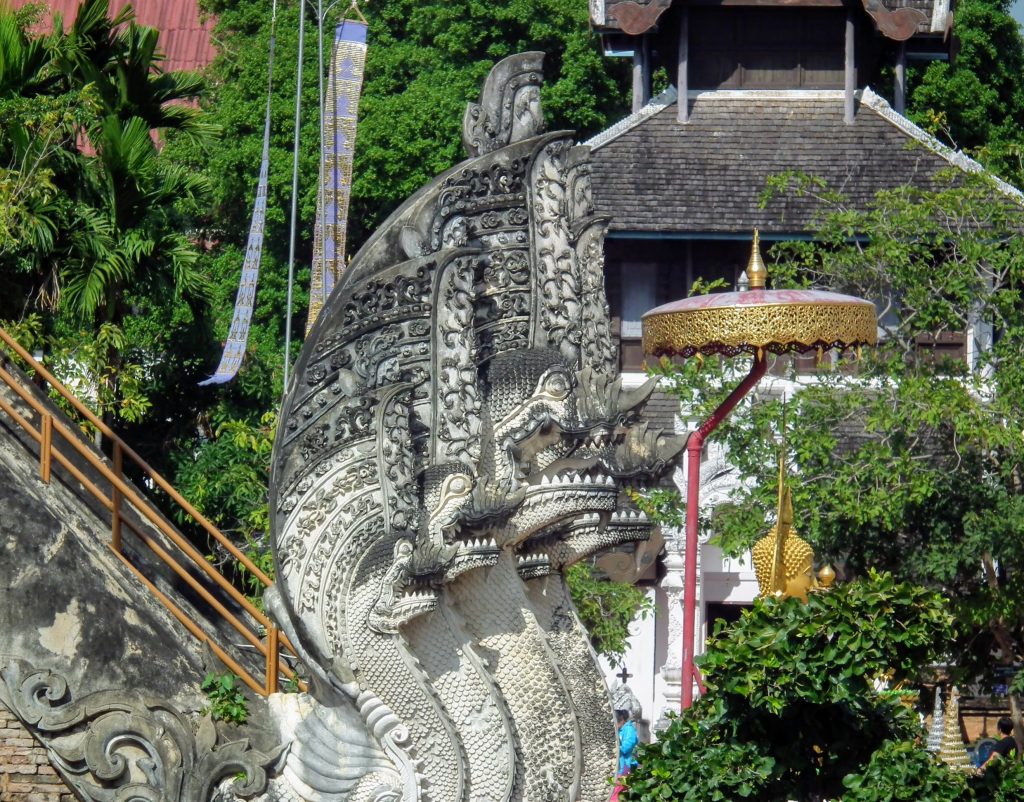
Some Nagas are strong and alluring, appearing as beautiful princesses who abduct men and carry them off to the underworld. In this sense, they share the same quality as the serpent in the Garden of Eden that tempts Eve into eating the forbidden fruit.
The Nagas were banished to the realm of Mahatala-Loka by Brahma and instructed to bite anyone with evil intentions (mistakes, bad energy). Given Nagas also represent higher conscious nature, their role in mythology reflects your need to learn from mistakes.
In ancient symbolism, serpents, together with dragons, represent energy and the flux of higher-lower consciousness. Vishnu is often found laying on his serpent-couch, Ananda, revealing that he has power over the duality of his personality. This shows he has transformed in The Supreme Self – he is at one with himself and nature as a whole.
The Naga then represent cravings and incidents you class as bad luck. But there is no such thing as bad luck. It is bad energy, and you have these experiences because there is something you need to learn about yourself.
The demon Gods of Danavas and Daityas rule the world of Rasatala-Loka. They are strong, but cruel and forever in direct conflict with the gods. In ancient symbolism, demons – known as asuras in Hindu myth – represent your faults and weaknesses.
During the process of self-development, you will encounter many demons, and your main weaknesses will show up in the latter two realms explained by the lower Lokas in Hindu mythology. These negative character traits are the easiest to identify and rectify.
In this state of conscious awareness, individuals typically experience a lot of chaos in their life and have little to no control over their actions – but nor do they recognise what they are doing is wrong.
Individuals which persist with a holier-than-thou attitude learn the hard way. From here there is only one place to go – Patala-Loka, or Hell. Don’t wait for disaster to strike, because the next stage is “rock-bottom”.
Rasatala-Loka is often a state of mind you experience as a teenager. This is because you continue to act in accordance with subconscious programs you developed as a child. Although the mistakes you made in this period of your life is all part of the learning curve, they were often hard lessons to learn.
It may be that you are still operating on some of the subconscious programs you developed as a child. This is not uncommon. How many adults do you see behaving like children?
How often is it you?
You have probably noticed yourself or your partner throwing a tantrum over the slightest little thing. It’s just frustration, but the cause is due to a deep-rooted belief you have carried with you since childhood.
Patala-Loka is the Hindu equivalent to the realm known as the Underworld, or Hell in many traditions around the world. In Hindu myth, Patala-Loka is the abode of the Serpent King, Vasuki who is killed by Indra and Vishnu when he threatens to destroy the population of Earth.
I expect most people have experienced what it is like to live in Hell on at least one occasion in your life. Fortunately, the majority of us never fall this low that often, but when you do, it’s usually an abrupt wake-up call.
The inhabitants of Patala-Loka are filled with hatred, malice and anger all the time. They are very abrupt people with a bad attitude and violent by nature. They hate themselves, the world and everything in it.
The esoteric symbolism of the 14 Lokas in Hindu mythology is often misunderstood. Master Mind Content has decoded ancient wisdom in relation to the mind-body-energy connection.
When you approach ancient symbolism from this perspective, not only does it make more sense than other theories, it is clearly the most beneficial and why else would ancient builders and wise sages go to such great lengths to build symbolism into their architecture and preserve writings that would survive for thousands of years.
Furthermore, why are the same symbols used by the ruling classes in modern society.
The historical compound therefore reveals secrets the puppet masters don’t want you to know.
I, on the other hand, think everyone has the right to know the secrets to life and am working towards explaining the deeper meaning of esoteric symbolism in relation to the human psyche and the transformation of bioenergy.
This is essentially how you perform self-development and improve your quality of life.
My long-term ambition is to publish a series of books explaining the meaning of esoteric symbolism and intend to deliver various courses explaining how you can effectively use ancient myth for the purpose of self-development.
For now, you’ll have to settle for the content published on this humble blog by way of an introduction. This particular article will look at several key aspects of the Supreme Gods in the Hindu Trimurti and offer a brief insight as to their esoteric meaning.
In a nutshell, the three Supreme Gods of the Hindu Trimurti are Brahma, the creator, Shiva, the transformer, and Vishnu the maintainer.
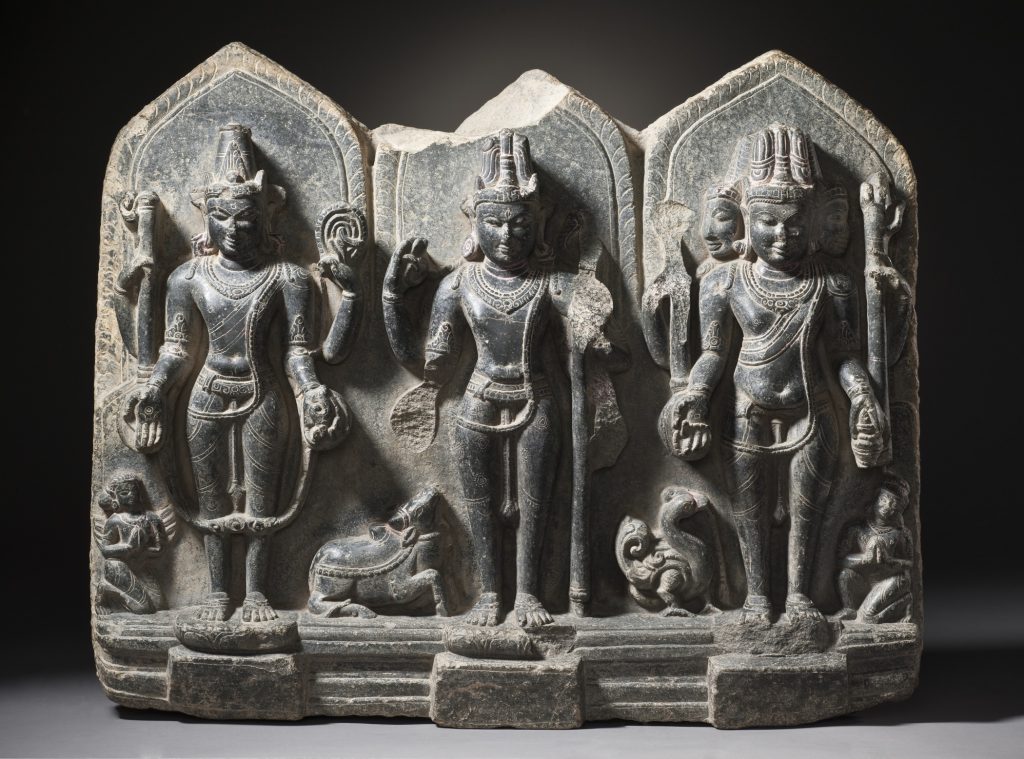
Vishnu (left) Shiva (centre) Brahma (right)
These labels of religious gods are [deliberately] ambiguous, but when you apply the meanings to a specific topic, the hidden meaning is revealed.
I interpret esoteric symbolism in relation to the mind-body-energy connection. In doing so I can vividly describe how you can cultivate mental and physical health, and create the life you want to experience.
Apply this to the Trimurti and you can see that Brahma is the creative energy, Shiva is the destructive and transformative process and Vishnu is tasked with maintaining that which becomes manifest.
Now allow me to explain how this principle works in the relation of self-development.
Thoughts, emotions and actions are energy. It is through thoughts, emotions and actions that you create your experiences in life. Brahma the creator.
During this time you adopt attitudes, beliefs and personality traits. This is the Vishnu, the maintainer. In Hindu myth, Vishnu reincarnates as various stages of “spiritual” maturity.
As you mature, your attitudes, beliefs and personality traits change. In order for this to happen, your old views of the world have to be dissolved in order for new ideas to take hold. This is the role of Shiva.
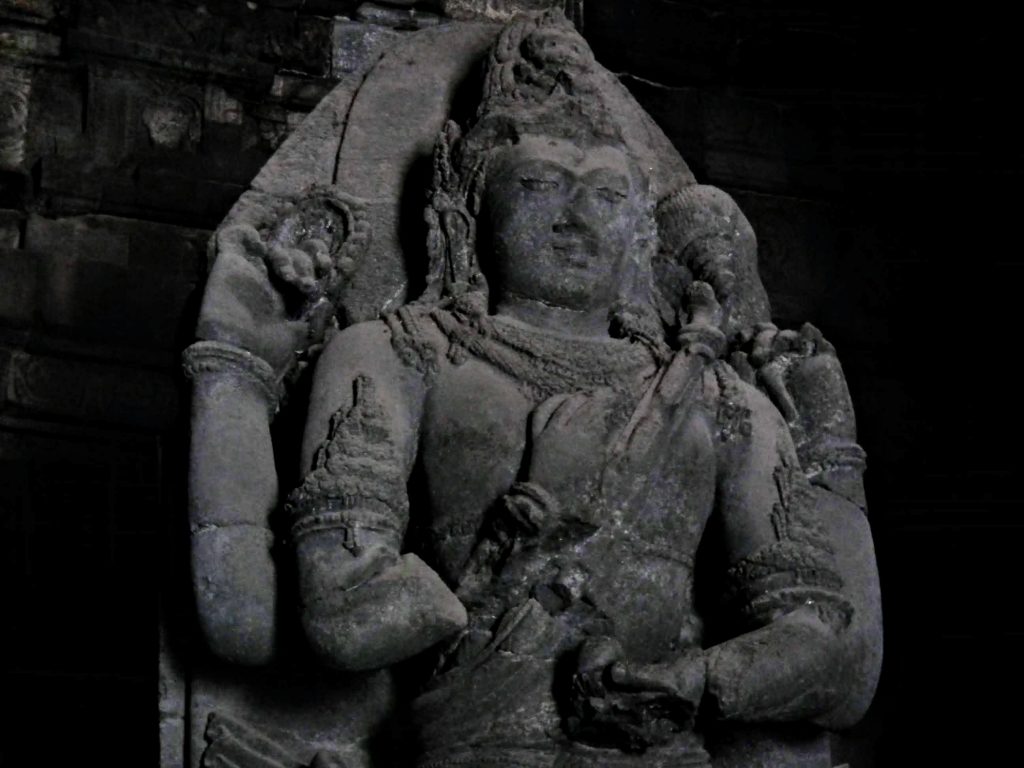
Shiva statue, Prambanan Temple
This is essentially what is meant by overcoming ego. However, changing something about yourself doesn’t necessarily mean you are dissolving ego – you could just be replacing one ego-centric behaviour with another one.
The goal of self-development is to identify weaknesses in your personality, attitudes and beliefs that create problems in your life and develop into the best version of yourself – your True Buddha Nature. How you identify your Buddha Nature can be found in ancient myths and many other philosophical writings.
Understanding the nature of your True Self is one thing. Obtaining the courage and the perseverance to acquire the wisdom and achieve it is an entirely different challenge altogether. But an understanding of the Hindu Trimurti and other gods in ancient myth certainly helps.
Prambanan is characterised by the three towering prangs, each of which is dedicated to one of the Hindu Trimurti.
The tallest building is the 47-metre-high temple in the centre dedicated to Shiva, the most powerful of the Supreme Gods in the Hindu pantheon.
In gematria, 47 = 11 a number of mastery. Essentially this number indicates you have the power and ability to overcome habitual thinking. This is why Shiva is known as the destroyer and transformer.
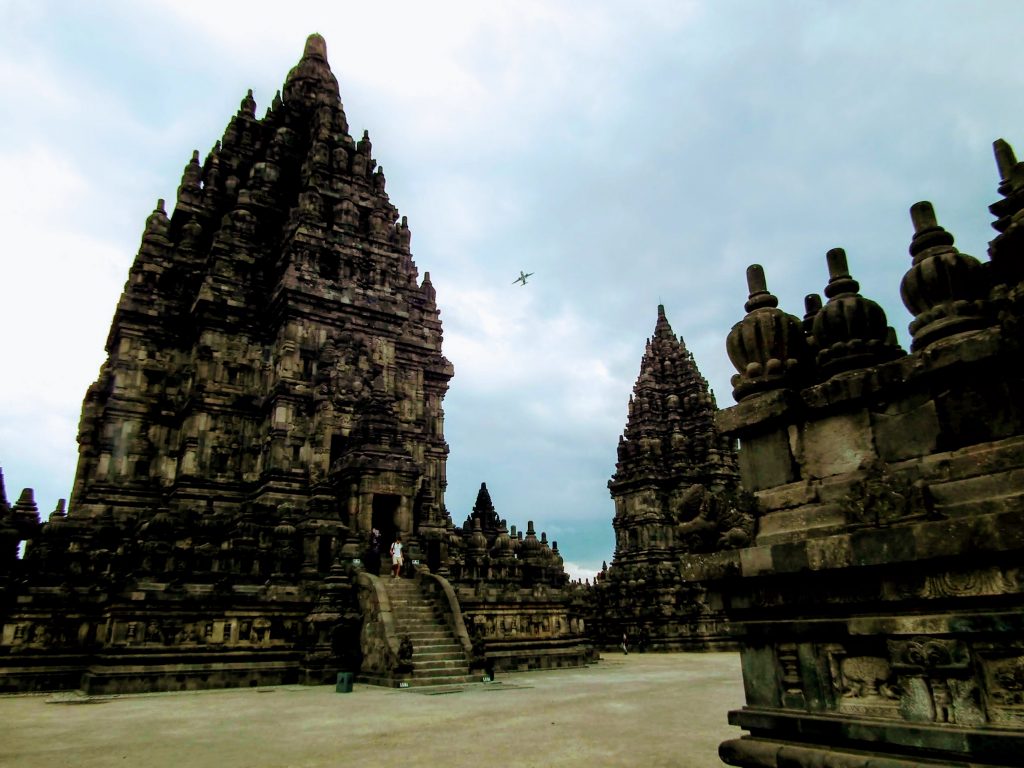
Shiva Temple
In contrast, the temples of Brahma and Vishnu are 33 meters tall which reflects total mastery over desires. Jesus died at 33 because he had complete control over himself. Forgiving his captures and the men that tortured him is a powerful image of the need for acceptance (of yourself and others). When you reach a status where you have complete control over your thoughts and emotions, you feel peace and harmony and maintain inner-knowing.
To get to that point however, you have to battle with the challenges of life that you subconsciously create.
These challenges are reflected in the various bas-reliefs etched on the walls of the gallery around each of the three shrines in Prambanan and recite in images the iconic Hindu epics, Ramayana and Bhagavata Purana.
The bas-relief you see below shows two men wrestling. This reflects the fight you have with the two voices in your head, the two aspects of your ego which Sigmund Freud called the id and the Superego.
The same principle is represented in other traditions by two warring brothers; Cain and Abel, Remus and Romulus, Set and Osiris.
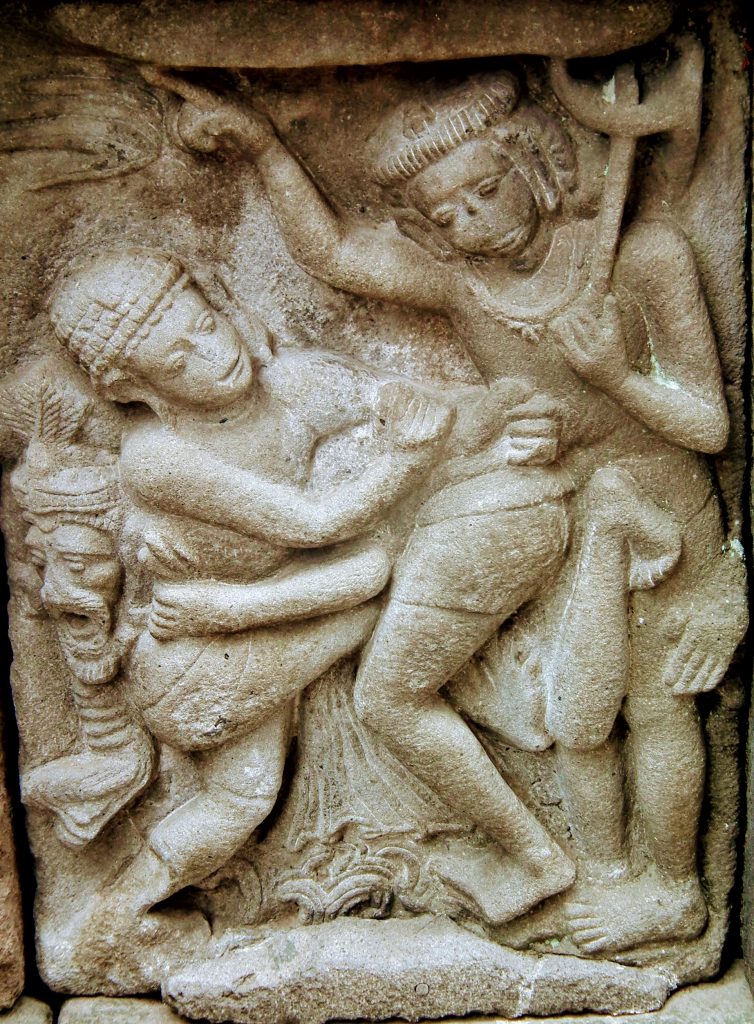
Sigmund Freud called the lower conscious nature of the subconscious mind the id which causes cravings and leads you into moments of weakness. At the higher end of the spectrum is the Superego which enables you to rationalise and determine the best cause of action. The Superego is the aspect of your consciousness that questions the choices you make that are rooted in ego.
This concept is often reflected in ancient mythologies by battles between gods and demons, warring brothers or a hero defeating a beast. Or as we see in the Indonesian legend below, the conflicts between kings and princes.
Prambanan Temple is also referred to as the Rara Jonggrang Temple in association with the mythological hero of the same name in Indonesian folklore.
Heroes in myth are you – the reader. The Gods are attributes and aspects of your personality – or in other words, the subtle energies that manifest as strengths and weaknesses – the archetypes described by Carl Jung.
The legend of Rara Jonggrang links the Prambanan Temple with the nearby Sewu Temple a short walk away. Sewu Temple is less crowded and well worth a visit.
Rara Jonggrang was a beautiful princess who was pursued by Prince Bandung Bondowoso (prince meaning an initiate/unenlightened individual with potential) – or in other words the habitual mind that is not illuminated.
The prince was from a neighbouring kingdom and asked for the princess’s hand in marriage, but she refused him because he had killed her father King Boko. Kings are the reigning attribute or trait as seen in Lord Vishnu – the maintainer.
King’s are ultimately replaced by princes’ just as old values are replaced by new views of the world. In this case, the king was being replaced by an enemy.
Bandung Bonowoso insisted that the princess become his bride and forced Rara Jonggrang into marriage – this is the alchemists “chemical union” between male and female principles (mind and heart).
The princess had no option other than to conceded her hand in marriage – but said she would only keep her word on one condition – that Prince Bandung builds her a thousand temples in one night.
This part of the story is reflected in the Sewu Temple.
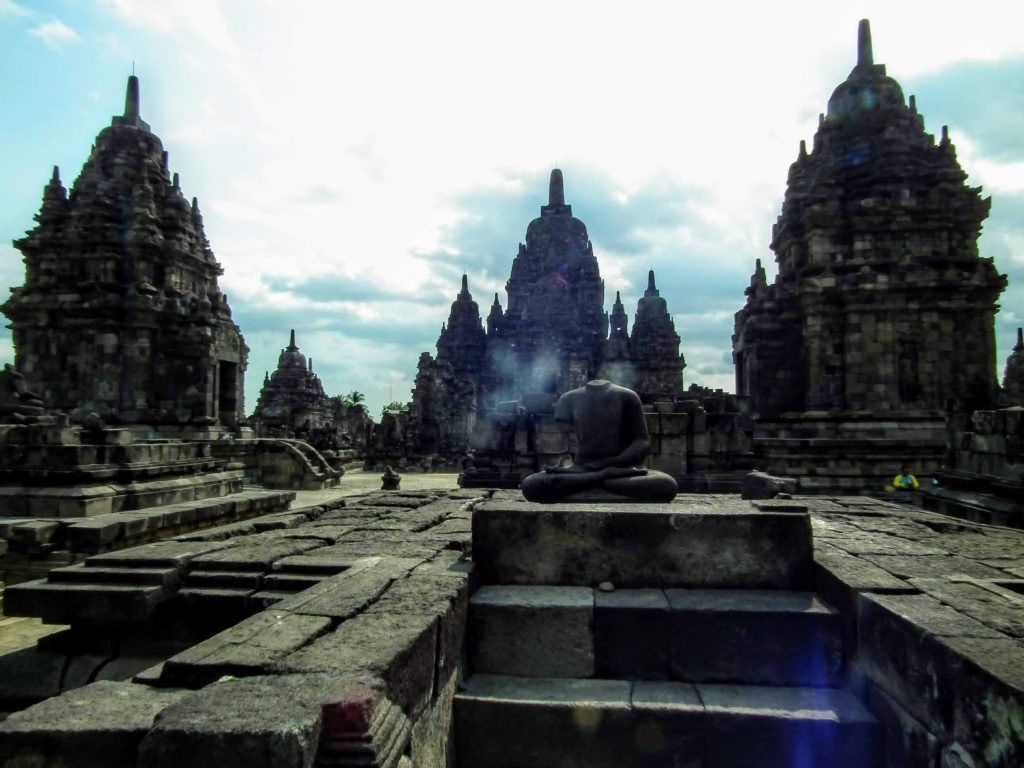
Sewu Temple, Prambanan Temple complex, Yogyakarta
The prince entered into meditation – set an intention – and called upon supernatural beings to help him complete the temple project. Just before daybreak, he had just one more temple to build.
To prevent him, the princess woke the palace maids and ordered the women of the village to pound rice and set a fire in the east of the temple so the cocks would think it was daybreak and sound their call.
Subsequently, the spirits returned to their den underground without finishing the project. When the prince discovered the ruse of the roosters, he was furious and turned Rara Jonggrang to stone.
The princess is said to be the statue of Durga which is housed in the north facing chamber of the Shiva Temple. Sewu Temple is the unfinished temple that was abandoned by the spirits.
So why is this legend so poignant to the symbolism in the Prambanan compound?
First of all, it reveals that greed and desire [of Prince Bandung Bonowoso] can hinder your progress in the quest to discover your Buddha Nature – the 1000th Temple which in gematria equals one – the one True Self that is liberated from ego.
This, of course, is a good lesson. What disturbs me is the link between the princess and the statue of the goddess Durga.
In Hindu mythology, the goddess Durga is an attribute of Lord Shiva. She represents the destructive forces of energy that enables you to overcome weaknesses; bad habits, poor attitude, limited views etc.
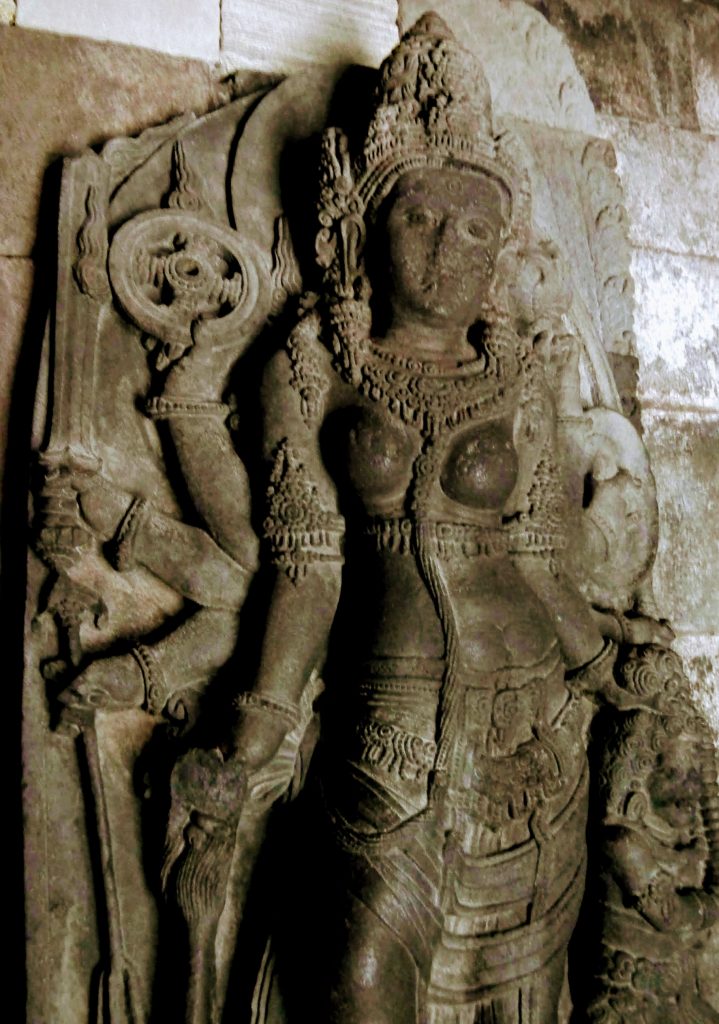
The statue of Durga, Shiva Temple, Prambanan
In essence, the goddess Durga carves out the path that enables you to create new energies and progress in life. This is an essential quality you need in order to grow and develop.
In the Indonesian legend of Rara Jonggrang, the princess also represents the qualities you need to reach or create perfection – reflected in her promise to Prince Bandung Bonowoso to complete 1000 temples – The True Self.
The marriage would essentially have been the heart and the mind coming together in harmony whereby all your creative energies are balanced.
However, the princess is turned to stone, the process of petrifaction – a natural process whereby wood, usually the lower trunk of a tree, turns to stone.
This is because a tree (wood) represents the central nervous system through which energy flows and the brain communicates with cells in the body. When the central nervous system is not fully functioning well, you will suffer from serious health problems.
When the flow of energy is obstructed it can also prevent you from taking action you know you need to take. You find yourself procrastinating because you are afraid or do not have the motivation to take the next step.
In Prambanan Temple, the petrified princess in the form of the goddess Durga is stored on the north chamber. The symbolic meaning of the north represents the subconscious mind whilst you are sleeping. This is when your energies transform.
So the statue of Rara Jonggrang-Durga represents your inability to destroy old value that does not serve you in order to create the qualities of character you need to develop.
Understanding the esoteric meaning of ancient symbolism not only helps you learn how to improve yourself, but also gives you the power to protect yourself from the masters that use you as a puppet.